
A state fair is an annual competitive and recreational gathering of a U.S. state's population, usually held in late summer or early fall. It is a larger version of a county fair, often including only exhibits or competitors that have won in their categories at the more-local county fairs.

The Minnesota State Fair is the state fair of the U.S. state of Minnesota. Also known by its slogan, "The Great Minnesota Get-Together", it is the largest state fair in the United States by average daily attendance and the second-largest state fair in the United States by total attendance, trailing only the State Fair of Texas, which generally runs twice as long as the Minnesota State Fair. The state fairgrounds, adjacent the Saint Paul campus of the University of Minnesota, are in Falcon Heights, Minnesota, midway between the state's capital city of Saint Paul and the adjacent city of Roseville, near the Como Park and Saint Anthony Park neighborhoods of Saint Paul. Residents of the state and region come to the fair to be entertained, exhibit their best livestock, show off their abilities in a variety of fields including art and cooking, learn about new products and services, and eat many different types of food—often on a stick. The Minnesota State Fair was named the best state fair in the United States in 2015 by readers of USA Today.
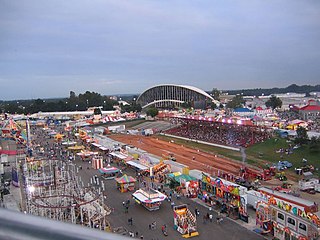
The North Carolina State Fair is an American state fair and agricultural exposition held annually in Raleigh, North Carolina. Founded in 1853, the fair is organized by the North Carolina Department of Agriculture and Consumer Services. It attracts around a million visitors over eleven days in mid-October.
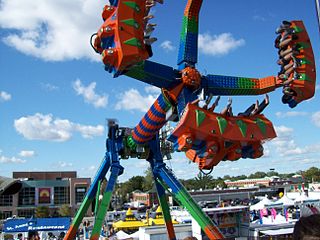
The Western Fair is a fair held annually in London, Ontario, Canada in early September.
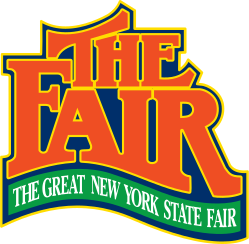
The New York State Fair, also known as the Great New York State Fair, is a 13-day showcase of agriculture, entertainment, education, and technology. With midway rides, concessionaires, exhibits, and concerts, it has become New York's largest annual event and an end-of-summer tradition for hundreds of thousands of families from all corners of the state. The first fair took place in Syracuse in 1841, and took permanent residence there in 1890. It is the oldest and one of the largest state fairs in the United States, with over one million visitors annually.
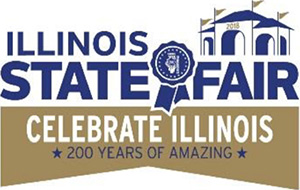
The Illinois State Fair is an annual festival, centering on the theme of agriculture, hosted by the U.S. state of Illinois in the state capital, Springfield. The state fair has been celebrated almost every year since 1853. Currently, the fair is held annually at the Illinois State Fairgrounds over an 11-day period in mid-August of each year.

The Missouri State Fair is the state fair for the state of Missouri, which has operated since 1901 in Sedalia, Missouri. It includes daily concerts, exhibits and competitions of animals, homemade crafts, shows, and many food/lemonade stands, and it lasts 11 days. The fairgrounds are located at 2503 W 16th Street on the southwest side of the city at the intersection of West 16th Street and South Limit Avenue.

The Oregon State Fair is the official state fair of the U.S. state of Oregon. It takes place every August–September at the 185-acre (0.75 km2) Oregon State Fairgrounds located in north Salem, the state capital, as it has almost every year since 1862. In 2006, responsibility for running the fair was delegated to the Oregon State Parks and Recreation Department, and the division is now known as the Oregon State Fair & Exposition Center (OSFEC), which holds events on the fairgrounds year-round.

The Big Fresno Fair, founded in 1884, is an annual fair held at the Fresno County Fairgrounds. The Big Fresno Fair is managed by the 21st District Agricultural Association, an entity of the California Department of Food and Agriculture Division of Fairs & Expositions. It is the largest annual event in the San Joaquin Valley, attracting around 600,000 people each October during its twelve-day run featuring exhibits, a livestock show, live horse racing, musical entertainment, educational programs and more. The Fair provides a link between urban and rural California, serving as a tool to educate visitors on the region's rich agricultural industry. The mission of The Big Fresno Fair is to "Educate, Celebrate and Have Fun".
The Tulsa State Fair is an annual event held at Expo Square in Tulsa, Oklahoma. The modern fair takes place in late September and lasts 11 days.

The Georgia National Fair is a state-sponsored fair that is held every October on the Georgia National Fairgrounds and Agricenter in Perry, Georgia, United States.

The Eastern Idaho State Fair is an American state fair held annually the first week of September in Blackfoot, Idaho. It is one of three annual state fairs in Idaho; the others being the Western Idaho Fair, which is held in Boise, the state capital, and the Northern Idaho State fair, held in Coeur d’Alene. The gates to the fairgrounds open on Labor Day weekend, the first week in September.

The South Florida Fair is an annual fair held in West Palm Beach, Florida every January. The fairgrounds site occupies 100 acres and is located on the site of the former Palm Beach Speedway at the intersection of Southern Boulevard and Fairground Road, adjacent to the iTHINK Financial Amphitheatre. In 2012, the fair celebrated its 100th anniversary since its founding in 1912. Nearly 500,000 people attend the South Florida Fair each year.
The Arizona State Fairgrounds is a permanent fairgrounds on McDowell Road, Encanto Village, within the city of Phoenix, Arizona, United States. It is currently used yearly to host the Arizona State Fair and the Maricopa County Fair, as well as for other events.

The California State Fair (CSF) is the annual state fair for the state of California. The fair is held at Cal Expo in Sacramento, California. The Fair is a 17-day event showcasing California's industries, agriculture, and diversity of people. The CSF features blue-ribbon animal displays, culinary delights and competitions, live music concerts, a carnival, fireworks, and other family fun. In 2018, officials reported daily attendance drew between 20,000 and 60,000 people per day and about $8.5 million of food and beverage expenditures. The fair is policed by the California Exposition and State Fair Police.
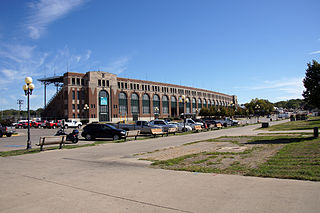
The Iowa State Fairgrounds is located on the east side of Des Moines, Iowa. It annually hosts the Iowa State Fair in late summer. The state fair was begun in Iowa in 1854 and the current fairgrounds were established in 1886. The fairgrounds were listed as a historic district on the National Register of Historic Places in 1987 as the Iowa State Fair and Exposition Grounds.

The Alaska State Fair is an annual state fair held in Palmer, Alaska, United States. The fairgrounds are located approximately one hour north of Anchorage and draw visitors from the entire Municipality of Anchorage and beyond for the popular 1½-week event beginning at the end of August. The fair is famous for its record setting giant vegetables and picturesque location at the foot of the Chugach Mountains in the Matanuska-Susitna Valley. The event features amusement rides, food concessions, competitive exhibits, carnival games, live performances and more.
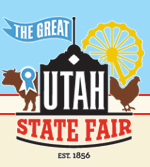
The Utah State Fair is held at the Utah State Fairpark in Salt Lake City, Utah, United States. The fairgrounds are listed on the National Register of Historic Places. The fair takes place each year starting on the first Thursday after Labor Day and lasts for 11 days.

The Central Washington State Fair is a state fair in Yakima County, Washington, United States held annually in September. The fair is held in Yakima, Washington at the State Fair Park. The fair was first held in 1892.
The DuQuoin State Fair is an annual festival, centering on the themes of agriculture and country music, hosted by the U.S. state of Illinois on an approximately 1,600 acres (650 ha) fairground site adjacent to the southern Illinois town of Du Quoin. The state fair has been celebrated almost every year since 1923. Currently, the fair is held annually over an 11-day period concluding on Labor Day of each year. However, in 1927, the fair opened on Labor Day.




















